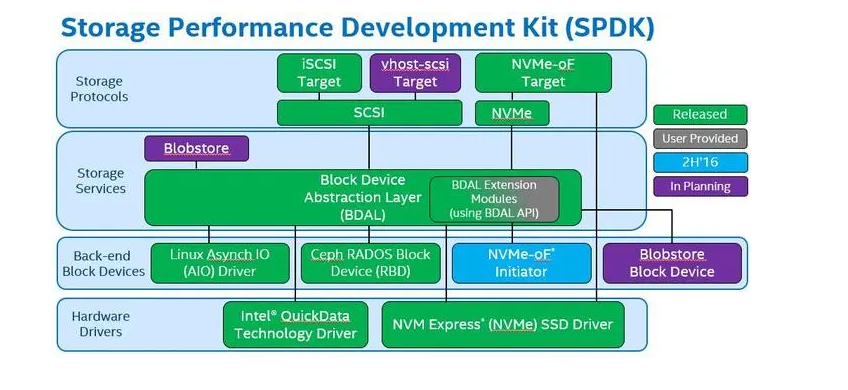DPDK中的Switch Representation主要是针对网络交换机的数据平面进行优化。它包括两个主要部分:流表规则匹配和动作执行。
下面是一个简单例子,展示了如何使用DPDK的Switch Representation来实现基本的流表规则匹配和动作执行:
#include <rte_ethdev.h>
#include <rte_flow.h>
// 定义流表项结构体
struct flow_item {
uint64_t src_mac;
uint64_t dst_mac;
uint16_t ether_type;
uint32_t ip_src;
uint32_t ip_dst;
uint8_t ip_proto;
uint16_t tcp_src_port;
uint16_t tcp_dst_port;
};
// 定义动作结构体
struct flow_action {
uint8_t set_vlan;
uint16_t vlan_id;
uint16_t output_port;
};
// 配置流表规则
static struct rte_flow *
configure_flow_rule(struct flow_item *item, struct flow_action *action) {
struct rte_flow_error err;
struct rte_flow_attr attr = {};
struct rte_flow_item pattern[7] = {};
struct rte_flow_action actions[3] = {};
struct rte_flow *flow = NULL;
// 配置流表属性
attr.ingress = 1;
// 配置流表匹配项
pattern[0].type = RTE_FLOW_ITEM_TYPE_ETH;
pattern[0].spec = &item->src_mac;
pattern[0].mask = &full_mask;
pattern[1].type = RTE_FLOW_ITEM_TYPE_ETH;
pattern[1].spec = &item->dst_mac;
pattern[1].mask = &full_mask;
pattern[2].type = RTE_FLOW_ITEM_TYPE_VLAN;
pattern[2].spec = &item->ether_type;
pattern[2].mask = &vlan_mask;
pattern[3].type = RTE_FLOW_ITEM_TYPE_IPV4;
pattern[3].spec = &item->ip_src;
pattern[3].mask = &full_mask;
pattern[4].type = RTE_FLOW_ITEM_TYPE_IPV4;
pattern[4].spec = &item->ip_dst;
pattern[4].mask = &full_mask;
pattern[5].type = RTE_FLOW_ITEM_TYPE_TCP;
pattern[5].spec = &item->ip_proto;
pattern[5].mask = &tcp_mask;
pattern[6].type = RTE_FLOW_ITEM_TYPE_TCP;
pattern[6].spec = &item->tcp_src_port;
pattern[6].mask = &port_mask;
// 配置动作
actions[0].type = RTE_FLOW_ACTION_TYPE_OF_SET_VLAN_VID;
actions[0].conf = &action->vlan_id;
actions[1].type = RTE_FLOW_ACTION_TYPE_OF_PUSH_VLAN;
actions[1].conf = &vlan_ethertype;
actions[2].type = RTE_FLOW_ACTION_TYPE_DROP;
// 创建流表规则
flow = rte_flow_create(port_id, &attr, pattern, actions, &err);
if (flow == NULL) {
printf("Failed to create flow rule: %s\n", err.message);
return NULL;
}
return flow;
}
// 执行流表规则
static void
execute_flow_rule(struct rte_flow *flow, struct rte_mbuf *pkt) {
int ret;
// 匹配包并执行动作
ret = rte_flow_validate(port_id, NULL, &pkt->packet_type, flow);
if (ret == 0) {
rte_flow_apply(port_id, NULL, &pkt->packet_type, flow);
}
}
// 初始化端口
static void
initialize_port(uint16_t port_id) {
int ret;
struct rte_eth_conf port_conf = {};
// 配置端口属性
port_conf.rxmode.max_rx_pkt_len = RTE_ETHER_MAX_LEN;
port_conf.txmode.mq_mode = ETH_MQ_TX_NONE;
// 初始化端口
ret = rte_eth_dev_configure(port_id, num_queues, num_queues, &port_conf);
if (ret < 0) {
printf("Failed to configure port %u: %s\n", port_id, strerror(-ret));
exit(1);
}
// 启动端口
ret = rte_eth_dev_start(port_id);
if (ret < 0) {
printf("Failed to start port %u: %s\n", port_id, strerror(-ret));
exit(1);
}
}
int
main(int argc, char **argv)
{
uint16_t port_id = 0;
struct rte_mbuf *pkt;
struct flow_item item = {};
struct flow_action action = {};
struct rte_flow *flow = NULL;
// 初始化DPDK环境
rte_eal_init(argc, argv);
// 初始化端口
initialize_port(port_id);
// 配置流表规则
item.src_mac = 0xb8e856a2c7e4;
item.dst_mac = 0x30b5c2a9d68d;
item.ether_type = RTE_BE16(ETHER_TYPE_VLAN);
item.ip_src = RTE_IPV4(192, 168, 0, 1);
item.ip_dst = RTE_IPV4(192, 168, 0, 2);
item.ip_proto = IPPROTO_TCP;
item.tcp_src_port = RTE_BE16(80);
item.tcp_dst_port = RTE_BE16(1234);
action.set_vlan = 1;
action.vlan_id = RTE_BE16(201);
action.output_port = 1;
flow = configure_flow_rule(&item, &action);
// 接收数据包并执行流表规则
while (1) {
pkt = rte_pktmbuf_alloc(mbuf_pool);
if (pkt == NULL) {
printf("Failed to allocate packet buffer\n");
continue;
}
rte_eth_rx_burst(port_id, 0, &pkt, 1);
execute_flow_rule(flow, pkt);
rte_pktmbuf_free(pkt);
}
return 0;
}
这个例子展示了如何使用DPDK的Flow API来配置流表规则和执行动作。在这个例子中,我们定义了一个flow_item结构体,指定了要匹配的数据包字段,以及一个flow_action结构体,指定了匹配成功后要执行的动作。然后我们调用configure_flow_rule函数来配置流表规则,并且在execute_flow_rule函数中检查是否有数据包与流表规则匹配,如果匹配,则执行指定的动作。
需要注意的是,这只是一个简单的例子,实际上在实现交换机数据平面时还需要考虑很多其他因素,如高性能、可伸缩性、安全等。





















